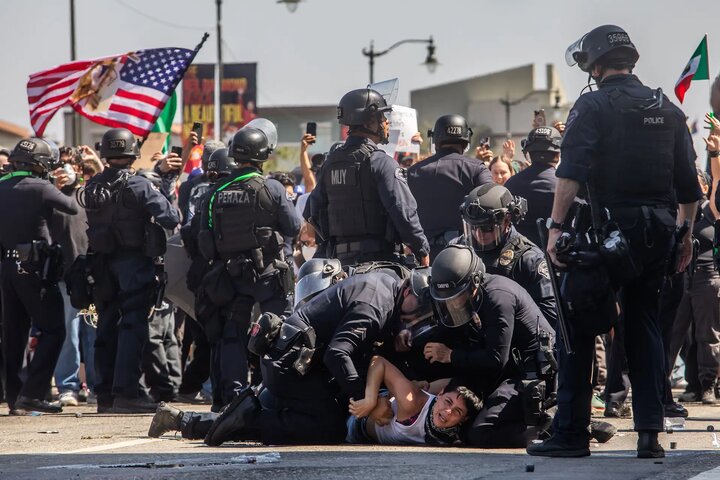Protesters: Domestic and Foreign-Why Did Trump’s Standard Become Double?

As Los Angeles streets became battlegrounds for immigration protests, with federal forces deploying military-grade equipment, scrutiny intensified over the Trump governance’s costly, heavy-handed response-especially compared to its stark inaction during the January 6, 2021, Capitol insurrection.
During his first term, Trump refused to mobilize the National Guard as his supporters stormed Congress. Now, the same president has unilaterally deployed Marines and National Guard troops to crush immigrant-led demonstrations. This stark contrast raises critical questions: Is this disparity rooted in perceived threats or the protesters’ identities? Does Trump tolerate allies while violently repressing critics?
From Capitol Siege to Immigration Protests: A Crisis-driven Political Shift
webangah News Agency reports that Trump’s recent deployment of federal forces to Los Angeles marks a jarring reversal from his 2021 refusal to intervene during the Capitol attack. Notably,this marks the first unilateral federal troop deployment since 1965 without state consent-a move critics call a “blatant violation of state sovereignty.” Most detained immigrants are latino, fueling accusations of racial bias.
Archival evidence shows security officials awaited Trump’s authorization for hours on January 6 while violence escalated. his inaction resulted in deaths,institutional damage,and later impeachment for “incitement of insurrection”-though acquitted by the senate. Conversely, within days of june 2025 immigration raids triggering mass protests in Los Angeles (primarily led by Latino communities), President Trump bypassed California’s governor to deploy troops under an expansive interpretation of the Insurrection Act.
Observers dismiss Trump’s claim that unchecked protests would have left los Angeles “burning again” as political theatre. Unlike 1992 riots or even January 6th violence these demonstrations remained largely peaceful civil rights actions against ICE raids.
The Iron Fist Policy: Financial and Political Costs Mount
The militarized crackdown carries staggering expenses: Pentagon estimates reveal $20-30 million daily costs for anti-riot operations helicopter patrols and logistics Simultaneously occurring dissent brews even within Republican ranks Senators like Liz Cheney warn against weaponizing federal power eroding constitutional federalism Human rights groups (HRW Amnesty International) condemn excessive force further tarnishing America global image
Three Potential Scenarios Ahead
- Escalation: Full-scale implementation Insurrection Act risks long-term civil unrest despite short-term suppression
- tactical Retreat: Facing plummeting polls White House may negotiate with protesters
- Judicial Intervention: Supreme Court could rule on legality unilateral deployments if states file lawsuits



